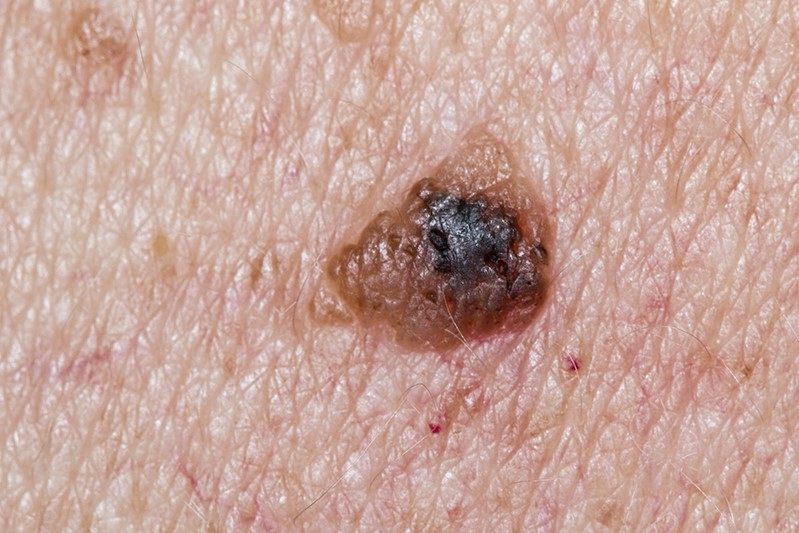
What is a dysplastic nevus and what does it look like?
The dysplastic nevus, also called atypical nevus, is a melanocytic pigmented lesion that may be present in up to 60-90% of the population
It is important to emphasise that this type of nevus is not necessarily synonymous with skin cancer, so it is best not to be alarmed prematurely.
According to the Skin Cancer Foundation, it is preferable to use the term ‘atypical nevus’ and to reserve the term ‘dysplastic nevus’ only after verification by histological examination.
The formation of these nevi depends on several factors, including familiarity and a predisposition to having numerous ones all over the body. How to recognise them?
The characteristics of the atypical (dysplastic) nevus
As mentioned, the atypical nevus is a small lesion that could, in a small percentage of cases, turn into a melanoma.
These nevi are most often congenital and vary in size: in most cases they do not exceed 8 mm in their major axis and are preferentially located on the trunk.
They can appear in the course of a lifetime in particular circumstances, such as during post-exposure to the sun, and especially in people with certain characteristics, such as
- women during pregnancy
- people with a light phototype (2A/2B);
- people who have difficulty tanning evenly;
- people who have freckles.
Other people at risk are those who have had repeated intermittent sunburns throughout their lives.
In view of these characteristics, if there is a family history and/or if there are more than 100 nevi, it becomes necessary to immediately schedule periodic check-ups to detect possible changes in the nevus that may prelude its transformation into melanoma.
How to detect a dysplastic nevus
In order to detect a dysplastic nevus the epiluminescence examination of nevi is certainly of great help and, in particular, the so-called rule of A, B, C, D, E, which allows the lesion to be monitored over time and immediately detect a possible transformation into malignant melanoma.
How the A, B, C, D, E rule works and what to look out for
This rule takes into account five characteristics of nevi:
A, possible Asymmetry of the nevus: a nevus must always be roughly rounded or oval in shape. The dermatologist who ideally divides the nevus in half during the epiluminescence examination must assess whether there is asymmetry of the nevus itself, i.e. whether one half is not exactly mirror-like to the other;
B, the Edges of the nevus: these should be sharp and regular, whereas in dysplastic nevus they are often jagged and look very much like a map;
C, the Colour of the nevus: this is given by the amount of melanin present in it. It is usually a light brick shade and is evenly distributed. In atypical nevi, there can very often be shades of brown (from light to dark, up to a black colour) and a possible simultaneous presence of several colours (e.g. white, red, blue) indicating that the nevus has turned into a melanoma;
D, the size of the nevus: as mentioned, nevi usually must not exceed 8 mm in their longest axis. The important thing is, when evaluating the patient’s nevi, to check for quantity, familiarity and the presence of the so-called familial melanoma syndrome with multiple atypical nevi (FAMMM).
And, the evolution of the nevus over time: this parameter is evaluated, comparing the data of the previous dermatological examination with the current one, in order to detect any morphological, structural and colorimetric changes of the nevus.
Beware of ultraviolet rays: how to defend yourself
Ultraviolet rays are harmful for our nevi,’ concludes the specialist.
Particularly during the summer period, to prevent them from further worsening the possible atypia of any nevus, it is necessary and fundamental to take simple protective measures by using good sunscreens with a high degree of protection:
- for adults, the sun protection factor (SPF) should be at least 30;
- for children, maximum protection (50+) is better.
Creams and lotions are better because they provide more even coverage than sprays, with application every 3-4 hours in the case of prolonged sun exposure.
Read Also:
Emergency Live Even More…Live: Download The New Free App Of Your Newspaper For IOS And Android
Epidermolysis Bullosa And Skin Cancers: Diagnosis And Treatment
Skin: What To Do In Case Of Folliculitis?
Childhood Psoriasis: What It Is, What The Symptoms Are And How To Treat It
Dermatological Examination For Checking Moles: When To Do It
What Is A Tumour And How It Forms
Rare Diseases: New Hope For Erdheim-Chester Disease
How To Recognise And Treat Melanoma
Moles: Knowing Them To Recognise Melanoma
Skin Melanoma: Types, Symptoms, Diagnosis And The Latest Treatments
Melanoma: Prevention And Dermatological Examinations Are Essential Against Skin Cancer
Symptoms And Causes Of Spitz Nevus


